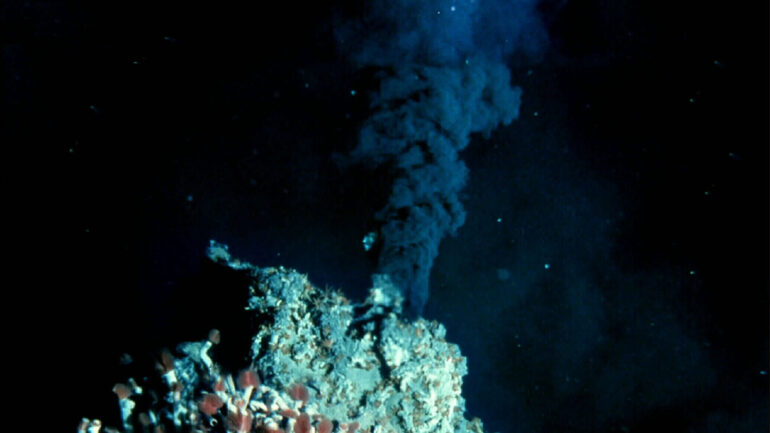The seafloor near a mid-ocean ridge is often home to rising hydrothermal fluids from the deep crust that deposit minerals on the ocean bottom. These seafloor massive sulfide deposits offer new sources of copper, zinc, lead, gold, and silver. The ore potential led to the European Union’s initiation of the Blue Mining project in 2014 with the goal of turning seafloor mining into a viable industry.
Two recent and related studies sought to optimize the detection and exploration of seafloor massive sulfide deposits. Both studies focused on the Trans-Atlantic Geotraverse (TAG) active mound at 26°N on the Mid-Atlantic Ridge. The studies addressed data collection at difficult-to-access seafloor sites and assessed their resource potential.
The first study, by Szitkar et al., used an autonomous underwater vehicle (AUV) to collect deep-sea passive electrical and magnetic data at active and inactive hydrothermal vent fields. The researchers attached a passive electrical sensor to the Abyss, a German AUV, which measured the disturbance of the ambient electric field caused by the chemical reactions occurring between the hydrothermal vents and the surrounding seawater. The electrical measurements provided an additional line of evidence for inherently risky research.
The study found a systematic correlation between deep-sea electrical and magnetic data; it yielded immediate geologic identification of both active and inactive hydrothermal vents. In addition, the approach eliminated the need to visually confirm the hydrothermal mounds.
The second study, by Galley et al., also used magnetic data but combined them with gravity measurements. Minimum-structure and surface geometry inversion were used to construct 3D models of the TAG active mound. These inversion methods find models that can reproduce the measured data.
The results from the modeling yielded a new geologic profile of the active hydrothermal mound. The models revealed the outer extent of the hydrothermally altered basalt rock below the vent and determined the thickness of the deposit. In addition, the models charted the movement of rising hydrothermal fluid and where it mixed with seawater. The study estimated the tonnage of the TAG active mound to be 2.17 ± 0.44 megatons, which agrees with past estimates.
The two studies are a significant step forward in identifying and characterizing active and inactive hydrothermal mounds on the seafloor. The findings move seafloor mining toward cost-effective exploration and assessment of currently undeveloped mineral resources, with a focus on exploiting the hydrothermally inactive deposit to minimize negative environmental impacts.
More information:
Florent Szitkar et al, Deep‐Sea Electric and Magnetic Surveys Over Active and Inactive Basalt‐Hosted Hydrothermal Sites of the TAG Segment (26°, MAR): An Optimal Combination for Seafloor Massive Sulfide Exploration, Journal of Geophysical Research: Solid Earth (2021). DOI: 10.1029/2021JB022082
C. Galley et al, Magnetic and Gravity Surface Geometry Inverse Modeling of the TAG Active Mound, Journal of Geophysical Research: Solid Earth (2021). DOI: 10.1029/2021JB022228
Provided by
American Geophysical Union
This story is republished courtesy of Eos, hosted by the American Geophysical Union. Read the original story here.
Citation:
Exploration and evaluation of deep-sea mining sites (2022, February 15)



